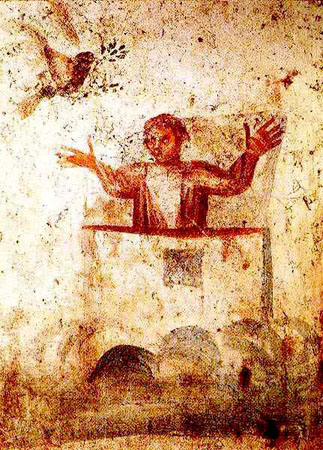I was going through my mental files today trying to find connections with the "ancestor" bit of information and I thought about the fact that
the very earliest, Pauline Christians, (the only kind that existed at very earliest times, actually), were all about "filial piety", which was a big thing for Julius Caesar, too (Romans in general).
Since all the Christian writings have been messed with or totally fabricated, the best way to get a feel for these people and what they were thinking and doing is to study the archaeology, monuments and so forth.
A few years ago I came across a reference to a book in something else I was reading: "Ante-Pacem: Archaeological Evidence of Church Life Before Constantine" by Graydon F. Snyder. Well, of course that really piqued my interest and it turns out to be really bizarre when you compare what the EARLIEST Christians were actually up to, against what we are TOLD.
Without getting into a big essay about it, the symbols they were using were: 1) lamb, 2) anchor, 3) vase, 4) dove, 5) boat, 6) olive branch, 7) the Orante, 8) palm, 9) bread, 10) the good shepherd, 11) fish, 12) vine and grapes. In no way were they using symbols of suffering and dying.
Early Christians had meals with their dead; in fact, the church communities would have meals - like picnics - in the catacombs or graveyards. Apparently, there was no concept of a distant afterlife; that came much later. It's almost like the commandment Paul writes about where Jesus supposedly instituted the Last Supper and said that people should do it "in remembrance of me". Well, maybe that's been altered a bit. Maybe what was really intended was that if you have a meal and commemorate not just Jesus/Caesar, but your loved ones, you can sort of invoke that energy/knowledge.
Of course, Paul expected an immediate Eschaton when the dead would all be resurrected for their new life as he conceived it, and I think that his reference to being baptized for the dead meant that people were invoking their deceased family members and being baptized on their behalf so everyone would be ready.
Maybe this was a case of Paul seeing things "through a glass darkly", not quite getting the real import?
Anyway,
one of the favorite symbols of the early Christians appears to have been Jonah and the whale. The term "Orante" refers to a standing female figure with arms stretched above her head. Her head is nearly always covered with a veil, and she wears a tunic of the period. The Orante is not a Biblical figure, she is Greco-Roman. She is the main figure in almost every scene of figurative art as well as being depicted alone more than any other symbol. Frequently she is accompanied by the inscription "pietas" which refers to familial piety and might represent the newly adopted family of the church. On the other hand, it might mean exactly what it suggests: invoking ancestors. There's a lot of nonsense written about it trying to explain it in current belief terms. See:
Orans - Wikipedia Some nice representations there, though they picked what they claim is Noah as the top image.
For all we know the figure is welcoming the Dove, the symbol of Venus, and Caesar claimed to be descended from Venus!!! So maybe it's Caesar?
Anyway, that's the short version. Anybody interested can pick up the book maybe, and try to read/weed through the overlay of modern belief in the interpretations of the figures. Just look at them and try to get inside the heads of the people using them as representations of what they believed.




